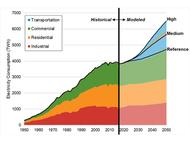Climate Change Playbook - ORIGINAL CONTENT
- By:
- Edward A. Reid Jr.
- Posted On:
- Jul 12, 2022 at 7:00 AM
- Category
- Energy Policy, Climate Change
It appears that the White House and at least two of the Executive Branch Agencies are not on the same page of the climate change “playbook”. The Administration has clearly enunciated goals of eliminating coal use by 2030, achieving fossil-free electric generation by 2035 and achieving Net Zero CO2 emissions by 2050.
The US Energy Information Administration (EIA) Annual Energy Outlook 2022 projects that petroleum and natural gas will remain the most-used fuels in the United States through 2050, based on consumer preferences, as shown in the graph below.

This projection is inconsistent with the Administration’s Net Zero goal. EIA projects total energy consumption of approximately 108 Quads, of which approximately 75 Quads is petroleum, other liquids and natural gas in 2050. Other renewable energy (predominantly wind and solar) increases from approximately 3 Quads to approximately 18 Quads, far short of the intended transition to a renewable plus storage goal with limited nuclear, hydro and liquid biofuels. Coal decreases from approximately 10 Quads currently to approximately 8 Quads by 2030 and to 6 Quads by 2050, rather than to zero by 2030 as proclaimed by climate czar John Kerry.
Similarly, the US National Renewable Energy Laboratory (NREL)projects that even what is described as “widespread electrification”, the high growth scenario projects electric consumption growth of 67%, mostly in increased consumption in the transportation sector (EVs). Note that this study is now 4 years old and was conducted during the previous Administration, prior to the goals set by the current Administration. The projected growth of electric consumption is far short of that which would result from the implementation of an “all-electric everything” goal to be achieved by 2050.

In its June 2018 Electrification Futures Study, the National Renewable Energy Laboratory (NREL) projects that even with “limited impacts” from electrification, U.S. electricity consumption could increase 21% over the 2016–2050 period (using moderate assumptions about technology changes), resulting in a compound growth rate of 0.65% per year. In the medium and high scenarios, which assume “widespread electrification,” electric consumption growth is 45% and 67%, respectively (compound annual growth rates of 1.2% and 1.6%, respectively). Source: NREL
This is not to suggest that these projections could not be changed if consumer preference is superseded by government fiat, as now appears likely to occur. However, replacement of three-quarters of projected future energy consumption with renewables plus storage would be a massive and extremely expensive undertaking. It would include abandonment in place of more than $50 trillion of fossil fuels, abandonment of large numbers of coal and natural gas generators before the ends of their useful lives and the installation of more than 1,000 GW of new wind and solar generating capacity (actual, not nameplate) plus storage capacity sufficient to carry the grid through the longest anticipated wind or solar “drought”. The storage technology required by this transition is not currently available.


